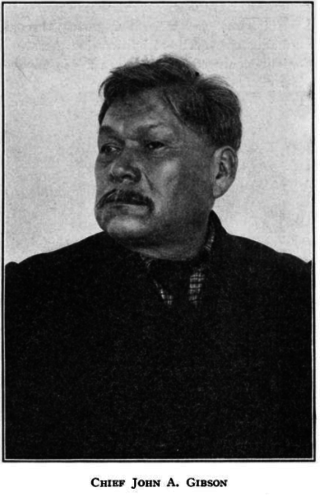
Hiawatha, also known as Ayenwatha or Aiionwatha, was a precolonial Native American leader and co-founder of the Iroquois Confederacy. He was a leader of the Onondaga people, the Mohawk people, or both. According to some accounts, he was born an Onondaga but adopted into the Mohawks.

Among the Haudenosaunee the Great Law of Peace, also known as Gayanashagowa, is the oral constitution of the Iroquois Confederacy. The law was written on wampum belts, conceived by Dekanawidah, known as the Great Peacemaker, and his spokesman Hiawatha. The original five member nations ratified this constitution near modern-day Victor, New York, with the sixth nation being added in 1722.

Thayendanegea or Joseph Brant was a Mohawk military and political leader, based in present-day New York, who was closely associated with Great Britain during and after the American Revolution. Perhaps the Native American of his generation best known to the Americans and British, he met many of the most significant Anglo-American people of the age, including both George Washington and King George III.

The Mohawk people are the most easterly section of the Haudenosaunee, or Iroquois Confederacy. They are an Iroquoian-speaking Indigenous people of North America, with communities in southeastern Canada and northern New York State, primarily around Lake Ontario and the St. Lawrence River. As one of the five original members of the Iroquois League, the Kanienʼkehá꞉ka are known as the Keepers of the Eastern Door – the traditional guardians of the Iroquois Confederation against invasions from the east.

The Great Peace of Montreal was a peace treaty between New France and 39 First Nations of North America that ended the Beaver Wars. It was signed on August 4, 1701, by Louis-Hector de Callière, governor of New France, and 1300 representatives of 39 Indigenous nations.

The Onondaga people are one of the original five original nations of the Haudenosaunee (Iroquois) Confederacy in the Northeastern Woodlands. Their historical homelands are in and around present-day Onondaga County, New York, south of Lake Ontario.

Six Nations is demographically the largest First Nations reserve in Canada. As of the end of 2017, it has a total of 27,276 members, 12,848 of whom live on the reserve. It is the only reserve in North America that has representatives of all six Haudenosaunee nations living together. These nations are the Mohawk, Cayuga, Onondaga, Oneida, Seneca and Tuscarora. Some Lenape also live in the territory.

The economy of the Haudenosaunee historically was based on communal production and combined elements of both horticulture and hunter-gatherer systems. Some have described the Iroquois economy as primitive communism. The tribes of the Iroquois Confederacy and other Northern Huron had their traditional territory in what is now New York State and the southern areas bordering the Great Lakes. The confederacy was originally composed of five tribes; the Mohawk, Onondaga, Oneida, Cayuga, and Seneca, who had created an alliance long before European contact. The Tuscarora were added as a sixth nation in the early eighteenth century after they migrated from North Carolina. The Huron peoples, located mostly in what is now Canada, were also Iroquoian-speaking and shared some culture, but were never part of the Iroquois.

The Treaty of Canandaigua also known as the Pickering Treaty and the Calico Treaty, is a treaty signed after the American Revolutionary War between the Grand Council of the Six Nations and President George Washington representing the United States of America.
The Great Peacemaker, sometimes referred to as Deganawida or Tekanawí:ta was by tradition, along with Jigonhsasee and Hiawatha, the founder of the Haudenosaunee, commonly called the Iroquois Confederacy. This is a political and cultural union of six Iroquoian-speaking Native American tribes residing in the present-day state of New York, northern Pennsylvania, and the eastern portion of the province of Ontario, Canada. The traditional stories and legends about Skennenrahawi do not provide a specific date or year for when he lived but Haudenosaunee tradition indicates 200AD - 300AD in lodge teachings. However, it is generally believed that he lived several centuries ago, likely in the pre-contact era of North American history when the Haudenosaunee (Iroquois) Confederacy was formed. The exact dates and historical details of this time period are often the subjects of ongoing research and debate among scholars and historians.
"Bury the hatchet" is an American English idiom meaning "to make peace". The phrase is an allusion to the figurative or literal practice of putting away weapons at the cessation of hostilities among or by Native Americans in the Eastern United States.

The Iroquois Tree of Peace finds its roots in a man named Dekanawida, the peace-giver. The legends surrounding his place amongst the Iroquois is based in his role in creating the Five Nations Confederacy, which consisted of the Mohawks, Oneidas, Onondagas, Cayugas, and Senecas, and his place as a cultural hero to the Haudenosaunee Nation, commonly known in Western culture as "Iroquois". The official title of the confederacy is, Kayanerenh-kowa as described by Paul A. Wallace, "it is also known as Kanonsionni, a term that describes both its geographical extent and its constitutional form". The myths and legends surrounding Dekanawida have the roots in the oral histories that followed many Native American tribes throughout their histories.

The Iroquois, officially the Haudenosaunee, are an Iroquoian-speaking confederacy of First Nations peoples in northeast North America and Upstate New York. They were known during the colonial years to the French as the Iroquois League, and later as the Iroquois Confederacy. The English called them the Five Nations, comprising the Mohawk, Oneida, Onondaga, Cayuga, and Seneca. After 1722, the Iroquoian-speaking Tuscarora from the southeast were accepted into the confederacy, which became known as the Six Nations.
John Skenandoa, also called Shenandoah among other forms, was an elected chief of the Oneida. He was born into the Iroquoian-speaking Susquehannocks, but was adopted into the Oneida of the Iroquois Confederacy. When he later accepted Christianity, he was baptized as "John", taking his Oneida name Skenandoa as his surname. Based on a possible reconstruction of his name in its original Oneida, he is sometimes called "Oskanondonha" in modern scholarship. His tombstone bears the spelling Schenando.

Tadodaho was a Native American Hoyenah (sachem) of the Onondaga nation before the Deganawidah and Hiawatha formed the Iroquois League. According to oral tradition, he had extraordinary characteristics and was widely feared, but he was persuaded to support the confederacy of the Five Nations.

Jigonhsasee was an Iroquoian woman considered to be a co-founder, along with the Great Peacemaker and Hiawatha, of the Haudenosaunee (Iroquois) Confederacy sometime between AD 1142 and 1450; others place it closer to 1570–1600. Jigonhsasee became known as the Mother of Nations among the Iroquois.
The Onondaga Council governs the Onondaga Nation, a sovereign nation, one of six nations of the Iroquois people, that lives on a portion of its ancestral territory and maintains its own distinct laws, language, customs, and culture. The "nation" is not governed by a Council of Chiefs since the notion of federalism and proportional representation was strictly adhered to. After the dissolution of the League, interests lie only in external matters such as war, peace, and treaty-making to further the unanimity of the United States government. Since Tadodaho was appointed to the council fire and given weapons to protect the sacred fire within the house, the Grand Council could not interfere in the internal affairs of the tribe. Their role was limited to matters between themselves and other tribes; they had no say in matters that were traditionally the concern of the ability of the clan names.

John Arthur Gibson (1850–1912) was a chief of the Seneca nation of the North American Iroquois confederation. Part Onondagan and part Senecan, he resided within the reserve of the Six Nations of the Grand River in Ontario, Canada. Knowledgeable about Iroquois culture, he is best known for the versions he provided of the Iroquois oral constitution, the Great Law of Peace. He acted as an advisor to the Canadian Department of Indian Affairs in matters relating both to Iroquois and non-Iroquois indigenous people. He was a well-respected player of the traditional Iroquois sport of lacrosse until he was blinded during a game when he was 31.

The flag of the Iroquois Confederacy or Haudenosaunee flag is the flag used to represent the six nations of the Haudenosaunee. It is a purple flag with four connected white squares and an eastern white pine tree in the center.

The Royaner are the hereditary male clan leaders within the Haudenosaunee Confederacy. They are chosen by their respective Yakoyaner to represent their clan at the confederacy level. The specific name-titles held by the royaner belong to the matrilineal lineages headed by the clan mothers. These male leaders are expected to serve their community for life, although there are ways of removing a royaner if he does not live up to his lineage's expectations. With the clan mothers, the royaner form the hereditary leadership that distinguishes itself from the elected Band Council imposed by the Canadian state.














